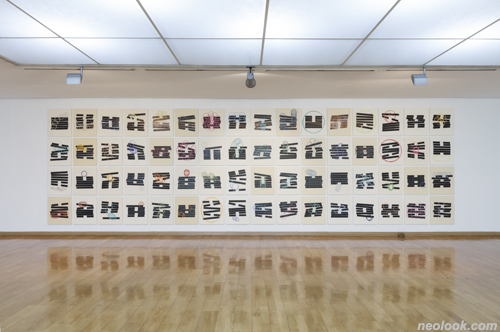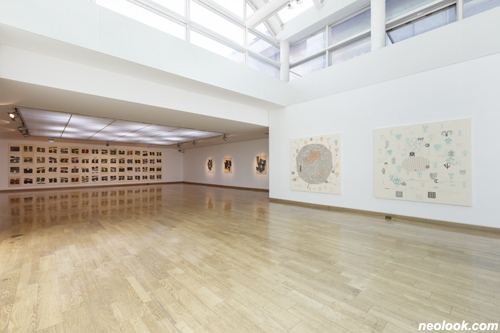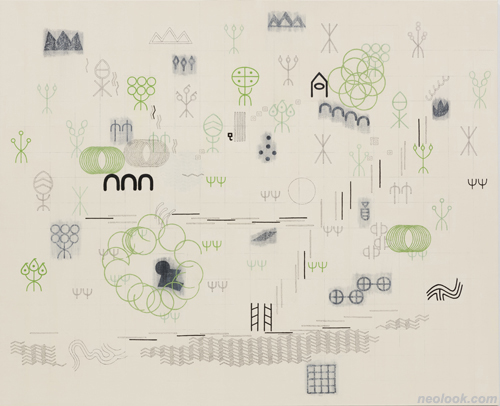- ● homepage
- ● archives
- ● restoration
- ● books
- ● big banners
- ● post board
- ■ neo's search
- ■ about us
- ■ 게재방법 안내
- 개인정보처리방침

- [email protected]
- Tel. 02_335_7922
- Fax. 02_335_7929
- 10:00am~04:30pm
- 월요일~금요일
- 3/3(월) 대체공휴일

문자 속 문자 文中文
송윤주展 / SONGYUNJU / 宋倫朱 / painting 2017_0930 ▶ 2017_1029 / 월요일,10월 1~6일 휴관
● 위 이미지를 클릭하면 네오룩 아카이브 Vol.20151027d | 송윤주展으로 갑니다.
송윤주 블로그_blog.naver.com/juice129
초대일시 / 2017_0930_토요일_04:00pm
영은창작스튜디오 10기 입주작가展
후원 / 경기도_경기도 광주시
관람시간 / 10:00am~06:00pm / 월요일,10월 1~6일 휴관
영은미술관 Young Eun Museum of Contemporary Art 경기도 광주시 청석로 300 (쌍령동 7-13번지) 제2전시실 Tel. +82.(0)31.761.0137 www.youngeunmuseum.org
영은미술관은 2017년 9월 30일부터 10월 29일까지 영은아티스트프로젝트 일환으로 영은창작스튜디오 10기 입주작가(단기) 송윤주 『문자 속 문자 (文中文)』展을 개최한다. 작가는 수십 번의 호분 칠이 올라간 장지 위에 상형문자와 음양기호(괘:卦)를 결합하여 우리 주변의 산수(山水)와 감정들을 담아낸다.

- 송윤주_돌마원 突馬園_한지에 먹, 안료, 스크래치_165×165cm_2017
'문자'를 주제로 한 작업의 시발점은, 화폭 속에 보여지는 구성 요소가 현재와 상이하지만 지난 2009년도로 거슬러 올라간다. 동양화를 전공한 작가는 형식적 구상화에서 탈피하여, 형태의 모호함에 강한 매력을 느껴왔으며 이 후 '추상' 장르에 깊은 관심을 가지고 상형문자(象形文字)와 64괘(卦)에 대해 지속적으로 연구해 오고 있다. ● 그는 항시 본인이 꿈 꾸는 세상, 힐링할 수 있는 공간이 결코 멀리 있지 않고 우리 주변의 공원과 산책로와 같은 곳이라 여겨왔다. 그렇기에 옛 선인들이 자연에 대한 동경으로 산수화를 그려 자연을 곁에 두고 싶었던 것과 같이, 바쁜 일상 속에 사는 우리들은 가까이 있는 자연을 찾고 이 속을 거닐며 이러한 경험에서 오는 소소한 즐거움을 찾는다고 보는 관점을 작품에 여실히 담고 있다. ● 수십 번의 호분칠이 스며들어 질료의 두께감이 묵직한 장지위에 먹선으로 그리고, 다시 사포로 문지르고를 반복해 가며 송윤주 작가만의 문자 회화도의 기조방식을 흥미롭게 구축해가고 있다. 특히 이번 전시는, 지난 2011년 『문자산수』展, 2015년 『이상세계以象世界』展의 마지막 작품 「산책」' 이 후, 영은창작스튜디오 입주 기간 동안 한층 더 완성도 높은 작품들을 선 보이게 되어 더욱 특별하다.

- 송윤주_율원 栗園_한지에 먹, 안료, 스크래치_165×165cm_2017
"이번에 전시되는 작품 중 「경안원」 「돌마원」 「율원」 등은 내 삶의 거처 주변에 존재하는 공원, 동산, 자연으로서의 공간이다. 마음속에서나 있을 법한 무릉도원이 눈을 돌려 바라보면 내 삶 가까이에 있는 것이다. 현대사회의 구성원으로서의 편리함을 추구하다 보면 도시인을 벗어나기 어렵고, 편리함은 황량함에 맞닿기 쉽다. 이에 처한 사람이 찾을 곳은 손과 발이 미치지 않는, 인간 너머에 있는 자연이 아닐까. 자연(自然)은 사람의 노력이 최소화될 때 스스로 존재하며 그 힘을 발휘하는 것 같다. 하늘과 땅, 산이나 연못, 물이나 불, 우레와 바람이 콘크리트 너머에 항상 존재함에도 고개를 돌리지 않으면 잊기 십상이다. 이들에게 다가가서 받은 선물이 이번 작품이다." (송윤주) ● 태고의 상형문자와 음양기호(괘 : 卦)의 만남을 시도한 이번 전시작품들을 마주하며, 그 곳에 담긴 다양한 의미도 찾아보고, 그 속을 거닐고 있는 자연 속 자아를 발견하며 명상해 볼 수 있는 시간을 만끽해보길 바란다. ■ 영은미술관

- 송윤주_일터 作業空間_한지에 먹, 안료, 스크래치_71×71cm_2017
송윤주-상기된 자연의 부호화 ● 송윤주의 근작은 「상」과 「괘상」 시리즈로 크게 나뉜다. 우선 상은 「경안원」, 「돌마원」, 「일터」라는 제목을 달고 있는데 모두 작가 자신의 즐겨 찾는 공원과 작업실 주변의 자연공간을 다분히 지도화 한 그림이다. 주어진 사물의 대상을 재현한 그림이 아니라 그 대상을 간략하게 부호화해서 표기하듯이 그려 넣었다는 느낌이다. 하늘에서 내려다 본, 조감의 시선으로 기입되어 있어서 흡사 나무를 심듯, 파종을 하듯 약호화 된 대상들이 가지런히 박혀있다. 그려진 그림이자 공들여 쓴 문자이기도 하다. 작가는 익숙해진 특정 장소를 채우고 있는 세세한 대상들, 그러니까 작은 건물과 다리, 물, 여러 종류의 나무와 구조물 등을 표기해두었다. 그곳을 거닐던 순간의 감정과 당시의 추억과 기억의 멀미, 자연과 자신이 신체가 결합해서 만들어진 사건들, 이른바 '물화物化'된 흔적이 녹아 있을 터인데 그것을 총체적으로 이미지화하고자 했을 것이다. 장자는 예술적으로 승화된 주관과 대상의 만남의 순간을 '물화'라고 불렀다. 그 결과물이 흥미로운 상형문자이고 재미있는 상징적 기호 또는 깜찍한 픽토그램이 뒤섞여진 그림으로 나왔다고 본다. "내 삶이 거처 주변에 존재하는 공원, 동산, 자연으로서의 공간이다. 하늘과 땅, 산이나 연못, 물이나 불, 우레와 바람이 콘크리트 너머에 항상 존재함에도 고개를 돌리지 않으면 잊기 십상이다. 이들에게 다가가서 받은 선물이 이번 작품이다." (송윤주)

- 송윤주_바람과 나무 風木_한지에 먹, 안료, 스크래치_90.9×72.7cm_2017
「괘상」시리즈는 『주역』의 64괘를 하나씩 자기 식으로 기호화해서 그려낸 그림이다.'하늘'에서 '미완성'까지 모두 64괘 상이다. 동일한 크기의 화면이 벽면을 가득 채운 이 64개의 괘상은 진한 먹으로 채워진 굵은 기학적인 선과 얇고 예민한, 다양한 색상을 지닌 원형이미지가 공존하면서 펼쳐진다. 모두 『주역』의 64괘가 지닌 뜻에 부합해서 그려낸 그림이다.

- 송윤주_흐름 流_한지에 먹, 안료, 스크래치_90.9×72.7cm_2017
수십 번의 호분 칠이 스며들어 견고하고 매끄러운 질감과 견고하고 투명한 바탕 면을 형성한 장지 위에 한자(상형문자)나 모종의 기호들이 도상화 되어 풍경을 구성하고 있다. 상형문자이자 팔괘이고 부호이자 픽토그램과도 같은 이미지들이 넓은 땅위에서 풀처럼 자라나는 화면이다. 형태의 아름다움이 무형의 공간에서 자유자재하게 구성되면서 그대로 풍경이 되었다. 여백의 느낌을 풍성하게 마련한 바탕은 미묘한 광택으로 은은하게 빛나고 있고 동시에 미끈하고 예민한 물성 역시 촉각적으로 전이된다. 이미 주어진 바탕 면 자체가 스스로 오브제 화 되고 있다는 느낌이다. 그 위로 검정의 먹색과 먹선이 주조로 깔린 화면 속으로, 몇 개의 색채를 머금은 원형이나 일련의 기호들이 감각적으로, 매끄럽게 개입하고 있다. 전체적으로 그 기호들은 기하학적인 패턴으로 응고되어 있다. 흡사 인쇄된 것처럼 정교하고 정밀하기도 하다. 간혹 어느 부위를 사포로 뭉개거나 흐릿하게 처리해 놓았다. 그 스크래치 된 흔적은 약간의 흔들림, 시간의 흐름, 소멸되는 존재의 자취, 어른거림이나 사라짐 등을 암유한다. 주역 64괘에서도 원형이미지들은 반복해서 겹치거나 소용돌이치듯 포개져 있다. 그것 역시 음과 양의 기세와 이동 등을 암시하는 구성일 것이다.

- 송윤주_멈춤 不動_한지에 먹, 안료, 스크래치_90.9×72.7cm_2017
이번 근작은 무엇보다도 작가 자신이 살고 체험한 주변 자연 풍경을 한자와 일련의 상징 부호로 번안해서 풀어놓았다. 전서를 좀더 그림에 가깝게 다듬어 상징화한 후 이를 공간에 배치해서 풍경을 구성하고 있고 직선과 곡선으로 기호화한 그림이다. 다분히 의고적인 뉘앙스가 짙게 우러나는 이 그림은 이른바 상형문자인 한자 부호가 현대적인 추상화 혹은 특이한 문자도로 환생하고 있음을 가시화한다. 태고의 상형문자와 『주역』의 64괘, 음양기호의 만남으로 이루어진 문자 그림을 통해 자신이 체험한 이곳의 구체적인 자연공간을 이미지화 한 것인데 나는 그 그림을 보면서 1974년도에 이응로가 변화의 철학인 『주역』의 원리 하나하나를 인체 형상과 일치하여 표현한, 이른바 서체추상을 시도했던 작품 「주역64괘 차서도」가 기억났고 동시에 박윤영의 「픽토그램산수」를 떠올렸다.

- 송윤주_문자 속 문자展_영은미술관_2017
산수화의 본래 의미는 자연의 기억 속에 남은 장면들을 상기하는 즐거움에 있다. 시각적 인상을 객관적으로 재생하는 것이 아니라, 풍경이 작가의 심리작용에 개입해 만든 자취와 사라지는 순간을 포착하여 고착시키고, 그 기억을 보존하는 일이었다. 그러니 산수화를 그리는 데 있어서 중요한 것은 물리적 현상의 재현이 아니라, '현상의 경험'이었던 셈이다. 또한 모든 것은 실재이면서 동시에 끝없는 변화의 과정 속에서 존재한다고 보았기에 그것을 쫓는 것은 결국 선이어야 했다. 여기서 선은 단순한 물리적 재현이 아닌 정신적 재현이 된다. 그래서 동양화는 사실적이기보다는 심리적 또는 지적 경로를 통과해서만 해독될 수 있는 그림이었다. 정신적 활력을 통해 완성되는 그림이기에 주어진 화면에 그려진 대상은 일종의 기호에 해당한다. 송윤주의 그림 또한 전통적인 동양화에서 자연을 보고 이미지화하는 방식의 추이를 쫓는다. 자신이 마주한 자연 공간과 그 위를 덮치는 시간의 흐름과 마음의 흐름, 의식의 흐름을 선으로, '역'의 형상으로 추려내고자 한다. 부단한 변화의 굴절을 겪어내는 현상의 이미지화!

- 송윤주_문자 속 문자展_영은미술관_2017
동양화에서 형은 사물이나 사람의 외재적인 모습이며 그러한 모습이 작품을 통해 재탄생하게 된 것을 형상이라 했다. 그런데 그림을 그린다 함은 바로 형상 너머의 '신神'을 전하는 것이다. 신은 형상에 내재된 정신적 함의, 즉 생명 혹은 사물이 운동하는 내재적 요인 및 생명의 본질을 일컫는다. 그런데 신은 형태를 초월하여 존재하므로 이것의 인지를 위해서나 표현을 위해서는 수양이 요구되었다. 그래서 사물에 내재한 정신적 요소를 작품에 옮겨내는 것에는 이른바'전신'의 기법에 대한 요구가 뒤따랐던 것이다. 송윤주의 그림 역시 나름 자기가 보고 체득한 자연 현상 너머의 본질이랄까, 정신을 어떤 식으로 표현할 수 있을까 하는 고민이 자리하고 있다는 생각이다. 동양화 전공자라면 당연히 그런 고민과 모색에서 자유로울 수는 없지 않은가? 그래서 작가는 산수화 제작과 유사한 목적 아래 그 자연을 품고 있으며 아울러 자연현상을 이해하는 주역의 논리, 시간의 흐름과 일획의 선, 전신사조, 그리고 서화동원론(『주역』에 근거해서 서법이 탄생했고 괘상은 문자의 시조요 만물의 근원이다. 여기서 그림은 곧 기호요 문자와 그림이 하나라는'서화동체'가 등장한다.) 등의 여러 요소들을 탑재한 지금의 그림을 시도하고 있다는 생각이다. 그리고 이를 통해 궁극적으로 "하늘과 땅, 산이나 연못, 물이나 불, 우레와 바람이 콘크리트 너머에 항상 존재"하고 있음을 새삼 환기시키고자 한다. 그것이 바로 작가가 시도하는 새로운 산수화의 한 변형인지도 모르겠다. ■ 박영택

- 송윤주_문자 속 문자展_영은미술관_2017
Yun Ju Song: A Symbolic Recollection of Nature ● Yun Ju Song's recent works can generally be divided into two images series: an image series of symbolic pictures and an image series of hexagrams from the I Ching. The image series of symbolic pictures features works such as Gyeongan Park, Dolma Park, and Workplace. These paintings form maps of the artist's favorite parks and the green spaces around her workplace. The objects in the spaces are not represented by true pictures, but rather with simple graphic representations. The bird's-eye view offers an image made up of simple representations of objects (such as trees), systematically filling an area, as if they had been sown and planted. It is simultaneously a visual image and a series of elaborate letters. The artist has depicted detailed objects, such as buildings, bridges, bodies of water, various kinds of trees, and other structures that fill a specific place that she is familiar with. She tried to express her emotions when she went for a walk there, her remembrances and misremembrances and of the day, her becoming one with nature, and the traces of "reification" that have begun to fade. The philosopher Zhang Zhao referred to the artistic meeting of the subjective and the objective as "reification." The end result of Song's work is a picture formed from a mixture of amusing, meaningful symbols and endearing pictograms. ● "Parks, gardens, and natural spaces are all around me in my life. It is easy to forget that sky and earth, water and fire, mountains and ponds, thunderstorms and winds are always present beyond the concrete, unless you turn to face them. These paintings are gifts that I have received from the natural world as a reward for turning and approaching it." (artist's note) ● The image series of hexagrams consists of the sixty-four hexagrams of the I Ching, which are depicted one at a time. In total, there are sixty-four hexagrams, ranging from "heaven" to "not yet complete." Song fills a wall with sixty-four images of identical size, showing bold geometric lines filled with dark ink along with thin, precise circles of various colors. This creates an overall image that is in accordance with the meaning of all sixty-four hexagrams of the I Ching. ● Song forms a sturdy, smooth, and transparent surface on Jang-gi paper (a traditional Korean paper) with dozens of layers of clam white paint. Chinese characters (pictographic characters) and other symbols are used to form a landscape. Shapes such as pictograms, the eight trigrams, symbols, and other representational iconography grow like a grass in an open field. The beauty of the shapes built in an intangible space without restrictions becomes a landscape. The white backdrop provides a rich feeling of blankness that shines subtlety, and its smooth, sensitive characteristics also feel tactile. The base of the painting becomes a shape in and of itself. Within the painting, over top of the black, painted lines, colorful circles or series of symbols are sensibly and smoothly integrated. The overall expression of the symbols is a geometric pattern. It is as sophisticated and precise as if it were printed. Occasionally, some areas are crumpled or faded by sandpaper. The scratch marks imply the passage of time, a slight fluctuation, a trace of extinction, a distortion, or a disappearance. In addition, circular images of the sixty-four hexagrams are repeatedly overlapped or swirled. The composition also suggests the momentum and movement of yin and yang. ● Song's recent work depicts the natural scenery that the artist lived near and experienced through the use of Chinese characters and a series of symbols. After changing and repurposing small seal script calligraphy into something resembling an image, she arranges it in a space to construct a landscape using straight and curved lines. The paintings use archaic nuance to reincarnate the Chinese characters as contemporary abstract paintings or unique munjado (pictorial ideographs). Through ideograph paintings that combine, pictographs, the sixty-four hexagrams, and the yin and yang symbol, she visualizes the specific natural spaces that she has personally experienced. Her paintings reminded me of Ungno Lee's I Ching: 64 Hexagrams, a work in his Abstract Letter series, in which Lee expresses each transformation of the I Ching via the shape of the human body. Song's work is also reminiscent of Yun Young Pak's Pictogram Landscape. ● Traditionally, the enjoyment of Asian landscape painting lies in the joy of recalling scenes that are held in nature's memory. Instead of objectively reproducing visual impressions, Asian landscape painting captures the psychological impression that the landscape had on the artist and preserves the memory of that impression. Therefore, what is important in painting landscapes is not the reproduction of physical characteristics but the reproduction of the experience of those characteristics. Everything in existence is in a process of endless change, and attempting to keep up with that change, the line of the artist is the greatest tool. The line is not merely a physical representation, but a psychological representation. So, traditional Asian landscape painting can only be deciphered through a psychological or intellectual lens rather than an objective one. Because the image is completed psychologically through mental effort, the object depicted in a given painting must correspond to a kind of symbol. Yun Ju Song's paintings follow the traditions of Asian paintings in in their way of seeing and expressing nature. She uses the lines of the hexagrams to depict the flow of the time, the flow of ideas, and the flow of her consciousness. Song overcomes the obstacles of endless changes! ● In traditional Asian painting, the external shape of a figure or a person is depicted, and the figure is said to be reborn in the work. But the point of drawing a picture is just to convey the "spirit" beyond the form. "Spirit" refers to the psychological connotations inherent in the image, the intrinsic understanding of the factors and the essence of life and movement. However, since "spirit" exists beyond form, it is necessary for artists to learn how to recognize and express it. Expressing the spiritual elements inherent in objects in a work of art requires "spiritual transmission" techniques. Song's painting has its own anxieties about how to express the essence or thought beyond the natural phenomenon that she has seen and experienced. If one is in the field of traditional Asian painting, can one be free from such troubles and pursuits? Song expresses nature with a goal similar to that of traditional Asian landscape painting. In addition, she presents pictures that bring in other elements such as the I Ching's logical understanding of natural phenomena, the flow of time and the line of a single stroke, the theory that painting transmits spirit, and the idea that calligraphy and painting share the same origin. (The I Ching is the birth of calligraphy and establishes that the trigrams are the root of all things and the origin of all things. Since painting and writing are both comprised of symbols, this theory states that they are of the same origin and are essentially the same thing.) In the end, Song attempts to recall that sky and earth, water and fire, mountains and ponds, thunderstorms and winds are always present beyond the concrete. This attempt requires her to transform landscape painting in a new way. ■ Young Taek Park
Vol.20170930c | 송윤주展 / SONGYUNJU / 宋倫朱 / painting

